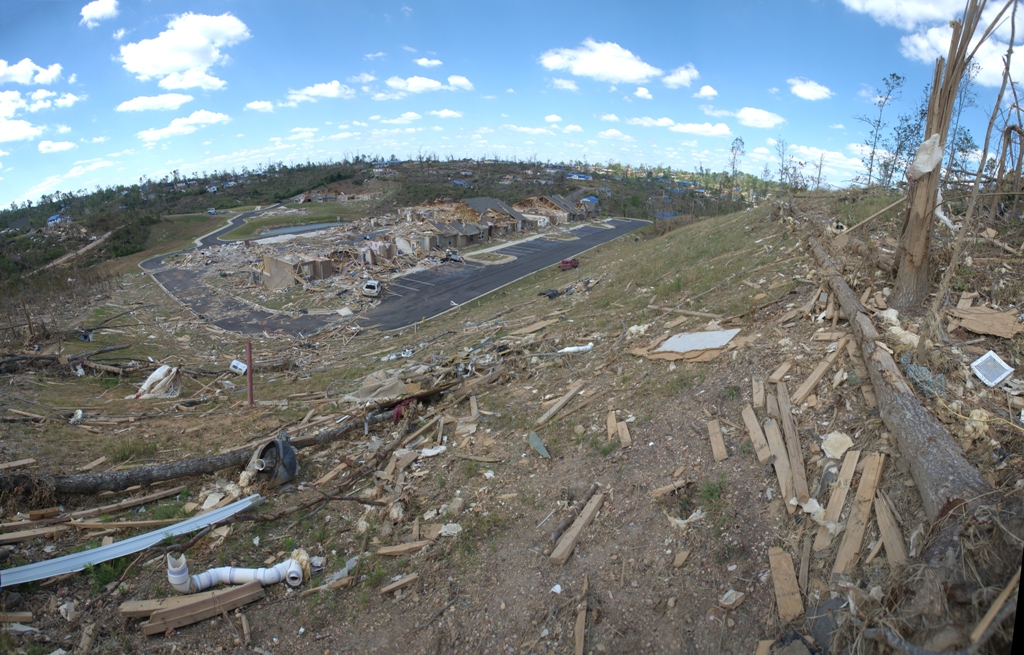By Mary Wymer and Misty Mathews
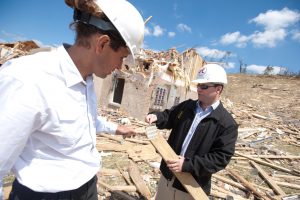
Carefully walking through tornado debris and stepping over split lumber that once supported a roof, University of Alabama engineers snap pictures.
Remembering that just days earlier this was someone’s home – but is now a pile of plywood, split timber, flooring and shingles – is, at times, overwhelming.
Concentrating on the photography helps – at least momentarily. It focuses the mind on the scientific project-at-hand – versus the alternative – contemplating the extent of this natural disaster that just struck your home city.
On April 27, 2011 a massive tornado hit Tuscaloosa. At points, it came within a few blocks of The University of Alabama campus. Fifty-two residents, county-wide, were killed. A preliminary study conducted by UA’s Alabama Center for Real Estate found that 5,144 residences were destroyed or damaged by the tornado. That figure represents approximately 12.6 percent of the city’s residences.
Afterward, over the course of four days, UA engineers collected more than 3,000 photos of family homes and apartment complexes. The overarching goal was to analyze wood-frame structures that were damaged by wind and windblown debris within Tuscaloosa’s 5.9-mile tornado path. The team determined the EF-Scale rating, in relation to damage for each structure, in order to develop a swath, or contour, map showing the localized intensity of the tornado.
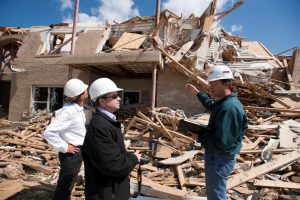
Following clearance from FEMA’s Engineering Division, the team inspected more than 150 structures in extensive detail. UA’s research team, consisting of academic researchers from multiple universities and professional engineers, received a National Science Foundation RAPID Response Grant for Exploratory Research for the project. The team primarily looked at houses and multi-family apartments, but it also reviewed some steel and masonry buildings.
“Through this multi-university and industry collaboration, we can provide valuable research to help design safer homes,” says Dr. John van de Lindt, UA’s lead investigator and professor of civil, construction and environmental engineering. “It is very difficult to investigate the load characteristics of buildings within a tornado path. Developing something we call a dual objective-based design method to better mitigate the effect of tornadoes will reduce damage and save lives.”
CHANGES COULD HELP STRUCTURES ON STORM’S EDGES
“Light-frame wood structures will not be able to withstand the EF4 and EF5 forces in the direct center path of a storm,” says Dr. Andrew Graettinger, UA associate professor of civil, construction and environmental engineering, “but the areas on the edges of a storm could see dramatic improvements in safety and overall structure through better engineering design and construction practices. The results of this study could impact many areas throughout the country by hopefully reducing the amount of damage sustained by the lower wind speeds seen on the edges of tornadoes.”
The level of damage to light-frame buildings at lower wind speeds was not acceptable and can be reduced through new engineering design and construction practices, the researchers say. The team recommends a systematic study focusing on the optimal threshold tornado wind speed for which engineers should be designing, an effort which could provide a uniform-risk design.
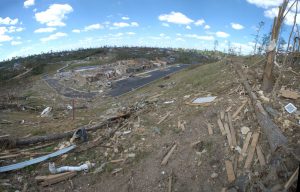
In addition, the researchers noted that virtually all buildings in the path of a strong tornado, even along the outer edges where wind speeds are lower, are irreparable based on current design and construction practices. This, the researchers say, provides incentive and an opportunity for developing tornado-resistant design and construction practices.
UA researchers also note that design and retrofit measures should be developed to reduce structural and component damage up to the threshold wind speed. Implementing hurricane region construction practices and products in tornado-prone regions is an excellent starting point, but it may not necessarily be an end solution, the researchers say.
While interior closets and bathrooms provide shelter at lower wind speeds on the edges of the tornado, they were no guarantee of survival, the research shows.
“The concept of a ‘safe spot’ should still be taught, but a safe spot is not a substitute for a safe room or tornado shelter,” says Graettinger. For wind speeds exceeding the threshold, the alternatives of a shelter or safe room can save lives.
The NSF grant, provided to The University of Florida to work in close collaboration with UA and other researchers, was urgent, as the type of information the researchers gathered would have been impossible to obtain once debris removal began.
CRISIS COMMUNICATIONS AND A SAFE EXAMPLE
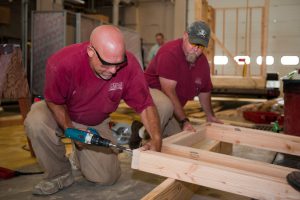
In addition to analyzing the structures, UA engineers, in separate projects, helped design a portable safe room, to serve as an example to contractors, and helped the city develop erosion-control concepts prior to the extensive rebuilding process to come. And, a UA expert in crisis communications found traveling to a disaster site is sometimes a short trip.
The Federal Emergency Management Agency partnered with the College of Engineering in May to help design a portable safe room as an example for the Safer Alabama Summit. Dr. Jim Richardson, associate professor of civil, construction and environmental engineering, led the team in designing the safe room and building the portable example that was displayed during the summit. It included cutaways of walls so contractors and builders could see the unique design needs of a safe shelter.
After the safe room’s completion, Richardson assisted Tuscaloosa Habitat for Humanity with specific safe room designs that could be incorporated into all new Tuscaloosa Habitat for Humanity homes.
Water Quality Priorities as Rebuilding Begins
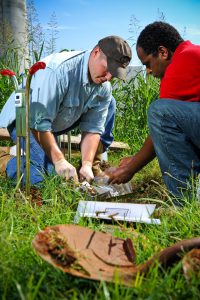
The city of Tuscaloosa is beginning the difficult task of rebuilding almost six square miles of the city, including residential and retail areas. As part of the effort, the city is managing how to enforce current building and water quality codes in those areas. For example, many long-standing retail establishments were built years before the water quality standards for runoff and storm inlets were enacted. Of course, businesses want to rebuild quickly, and the city wants to uphold landscaping ordinances.
Dr. Robert Pitt, Cudworth Professor of Civil Engineering and director of UA’s Environmental Institute, is working with the city in developing erosion-control concepts and looking at landscaping options to help with bioretention areas to encourage stormwater infiltration.
Pitt’s summer 2011 class focused on erosion control and worked at several sites in the city. The group also helped small commercial sites meet the current redevelopment requirements. Pitt’s fall class focused on stormwater issues for both retail and residential areas.
THIS TIME, IT WAS PERSONAL
For Dr. Suzanne Horsley, assistant professor of advertising and public relations and an American Red Cross volunteer, research and real life collided in an urgent way April 27.
“I’m a national public affairs volunteer for the Red Cross,” says Horsley, whose primary area of research is crisis communication. “I’m trained to deploy to disasters. This is the first time I’ve ever lived in a disaster. I’d never even heard a tornado siren until I moved here.”
Horsley spent the hours, days and even weeks after the April 27 tornado living in the midst of her own research. Through a whirlwind of media interviews, donation collections and relocation of the local Red Cross chapter after its building was destroyed, she got a glimpse into the very heart of crisis communication.
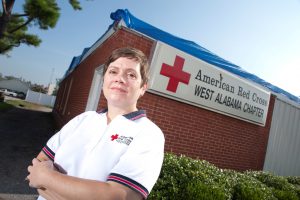
“This has been the first time I’ve been personally affected by a disaster,” Horsley says. “Not only that, but instead of deploying to a disaster for a short time and then going home, I had to stay. I wasn’t going to leave at the end of my three-week deployment.”
Horsley’s involvement with the Red Cross originated with field research in the organization’s Washington, D.C., office. She observed the Red Cross’s set-up for Barack Obama’s 2009 presidential inauguration. She went on her first deployment as a volunteer to Fargo, N.D., during the city’s spring flooding season.
“I was working in a communication function while in Fargo, so I was fully engaged in the whole activity,” Horsley says. “I was a complete participant in my research. When it comes to field work, that is really the ultimate, where you are a part of it and can really learn from the inside out.”
A CRISIS UP CLOSE
These two experiences allowed Horsley to understand how the Red Cross carries out its communication processes under uncertain, time-sensitive conditions. She said the research helped her set up a theory-based model called crisis-adaptive public information, which she has been developing since her dissertation work at the University of North Carolina at Chapel Hill in 2006.
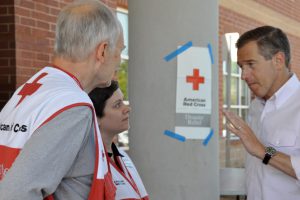
The model examines an organization’s shift from routine communication to disaster communication and what organizational characteristics allow that shift to happen. The idea is that these characteristics could also be applied within other organizations to make them more effective.
As for the Tuscaloosa tornado, Horsley says she considers it an “opportunity to explore disaster up close and personal and an opportunity to help other organizations be more prepared in terms of communication.”
She said the disaster took some time for her to process; she was huddled in a tiny nook with her husband and two neighbors in her home when the tornado struck. But “now that I’ve had a little time to process it myself,” she said, “I have a couple of studies I’ve put together. I’ve been writing about my experiences doing public affairs with the Red Cross and what I’ve learned from it.
“Being able to watch Tuscaloosa rebuild from this is going to be a unique experience for me. This will provide research material for a long time to come.”
Through her role in the University’s advertising and public relations department, Horsley was also able to involve some of her students in volunteering with the Red Cross. A group of six public relations students formed a local public affairs team, started a blog and assisted in keeping the chapter’s Facebook and Twitter up-to-date.
“The Chinese character for crisis is a mix of danger and opportunity,” Horsley says. “This crisis in Tuscaloosa – yes, it was a danger. But look at the opportunities to come together as a community, get students involved in helping, and conduct research that can help mitigate disasters in the future. That’s very rare, and I didn’t want to miss out on my opportunity to use my skills and background to help Tuscaloosa.”
